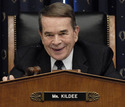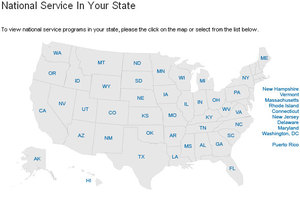The Healthy, Hunger-Free Kids Act of 2010 (S. 3307) will dramatically improve children?s access to nutritious meals, enhance the quality of meals children eat both in and out of school and in child care settings, implement new school food safety guidelines and, for the first time, establish nutrition standards for all foods sold in schools. This legislation will answer President Obama and First Lady Michelle Obama's call to reduce childhood hunger and support school and community efforts to reduce childhood obesity.
The legislation:
Improves Access
- Increases the number of children enrolled in the school meals programs by using Medicaid data to directly certify eligible children. This provision will connect approximately new 115,000 students to the school meals program.
- Enhances universal meal access for eligible children in high poverty communities by using census data to determine school wide income eligibility.
- Provides more meals for at-risk children nationwide by allowing Child and Adult Care Food Program (CACFP) providers to be reimbursed for meals provided to low-income children after school. This provision will provide an additional 21 million meals annually.
- Provides funding for innovative state and local projects to address childhood hunger and promote food security for low-income children.
Increases Focus on Nutrition Quality and Children's Health
- Improves the nutritional quality of school meals by increasing the federal reimbursement rate for school lunches for districts who comply with federal nutrition standards. This additional 6 cents per meal will be the first real reimbursement rate increase in over 30 years.
- Removes junk food from schools by applying nutrition standards for all foods sold in schools.
- Promotes nutrition and wellness in child care settings by establishing nutrition requirements for CACFP.
- Connects more children to healthy produce from local farms by helping communities establish farm to school networks, create school gardens and use more local foods in cafeterias with $40 million in mandatory funding.
- Strengthens local school wellness policies by updating existing requirements, increasing transparency, providing opportunities for community involvement, and compliance measurements.
- Supports breastfeeding for low-income women by supporting data collection in WIC and permanently authorizing performance bonuses for exemplary breastfeeding practices at WIC clinics and agencies.
Improves Program Management & Program Integrity
- Supports schools' food service budgets by ensuring charges to school foodservice accounts are only for allowable expenses.
- Supports a skilled workforce by establishing professional standards and training opportunities for school food service providers.
- Streamlines program administration by giving CACFP providers greater flexibility with their administrative funds and eliminating duplicative paperwork requirements and wasteful monitoring practices.
- Increases efficiency and modernizes the WIC program by transitioning to an electronic benefit program.
- Improves food safety requirements for school meals by improving recall procedures and extending existing HACCP requirements to all places where school meals are prepared or served.
Fully Paid For -- At No Cost to Taxpayers
- Saves $1 billion over 10 years by extending a provision that allows the Secretary of Agriculture to count commodities purchased for market stabilization toward the required level of federal support (in the form of commodity foods) for the National School Lunch Program.
- Saves approximately $1.3 billion over 10 years by restructuring nutrition education in the Supplemental Nutrition Assistance Program (SNAP) into a new grant program that distributes Federal funds by formula to the States.
- Saves approximately $2.2 billion over 10 years by eliminating a temporary SNAP benefit increase provided by The American Recovery and Reinvestment Act (ARRA).
National
- Abbott
- Academy of Breastfeeding Medicine
- Action for Healthy Kids
- Advocates for Better Children's Diets
- African Methodist Episcopal Church
- AFSCME
- AIB International
- Alliance to End Hunger
- American Academy of Pediatrics
- American Association for Health Education
- American Bakers Association
- American Beverage Association
- American Cancer Society Cancer Action Network
- American Clinical Board of Nutrition
- American Commodity Distribution Association
- American Congress of Obstetricians and Gynecologists
- American Council for School Social Work
- American Dental Association
- American Diabetes Association
- American Dietetic Association
- American Federation of Teachers
- American Feed Industry Association
- American Fruit and Vegetable Processors and Growers Coalition
- American Heart Association
- American Medical Student Association
- American Mushroom Institute
- American Public Health Association
- American Pulse Association
- American School Health Association
- American Society of Bariatric Physicians
- Apple Processors Association
- Asian & Pacific Islander American Health Forum
- Associated Food Stores, Inc.
- Association of State & Territorial Public Health Nutrition Directors
- Association of Teachers of Maternal and Child Health
- Baby-Friendly USA, Inc.
- Barilla America
- Board on Human Sciences, Association of Public and Land-grant Universities
- Bread for the World
- C&S Wholesale Grocers, Inc.
- Camp Fire USA
- Campaign for Better Nutrition
- Campaign to End Obesity Action Fund
- Catholic Charities USA
- Catholic Healthcare West
- Center for Oral Health
- Center for Science in Public Interest
- Child and Family Policy Center
- Child Nutrition Initiative
- Christian Church Disciples of Christ
- Christian Methodist Episcopal Church
- Church of the Brethren
- Church World Service
- CMA Consulting Services, Inc.
- Colorpoint - Low Temp Industries, Inc.
- Communications Workers of America
- Community Action Partnership
- Community Food Security Coalition
- ConAgra Foods, Inc.
- Defeat Diabetes Foundation
- Diocese of the Armenian Church in America
- Domino's Pizza
- E S Foods
- Earth Day Network
- Ecotrust
- End Hunger Network
- European Congress PTA
- Evangelical Lutheran Church in America
- Family Farm Defenders
- Feeding America
- FGE Food & Nutrition Team
- First Focus Campaign for Children
- Florida Dietetic Association
- Food and Water Watch
- Food Chain Workers Alliance
- Food Lion, LLC
- Food Marketing Institute
- FWE/Food Warming Equipment
- Generations United
- Grain Foods Foundation
- Greek Orthodox Archdiocese of America
- Grocery Manufacturers Association
- Hannaford Supermarkets
- Healthy Food Coalition
- Healthy Schools Campaign
- Healthy Schools Network
- Healthy Solutions
- Heartland Flavors, Ltd.
- Heifer International
- Independent Bakers Association
- Institute of Shortening and Edible Oils
- International Bottled Water Association
- International Center for Traditional Childbearing
- International Council of Community Churches
- International Dairy Foods Association
- International Federation of Professional and Technical Engineers (IFPTE), AFL-CIO
- International Formula Council
- International Ice Cream Association
- J.T.M. Food Group
- Jewish Council for Public Affairs
- Jewish Federations of North America
- Jewish Reconstructionist Federation
- Johnson & Johnson
- Jones Valley Urban Farm
- Juice Products Association
- LaLeche League
- Lamaze International
- Land O'Lakes, Inc.
- Leadership Conference of Women Religious
- League of United Latin American Citizens
- Learning Disabilities Association of America
- Mars, Inc.
- Mead Johnson Nutrition
- Medela, Inc.
- MEND Foundation
- Metropolitan Community Churches
- Milk Industry Foundation
- Milkin' Mamas Breast Milk Donations
- Moravian Church in America
- National Action Against Obesity
- National Advocacy Center of the Sisters of the Good Shepherd
- National Alliance for Breastfeeding Advocacy
- National Assembly on School-Based Health Care
- National Association for Sport and Physical Education
- National Association of Chronic Disease Directors
- National Association of County & City Health Officials
- National Association of Local Boards of Health
- National Association of Pediatric Nurse Practitioners
- National Association of School Nurses
- National Association of State Boards of Education
- National Black Church Initiative
- National Cheese Institute
- National Coalition of 100 Black Women
- National Congress of Black Women, Inc.
- National Consumers League
- National Corn Growers Association
- National Council for Community and Education Partnerships
- National Council of Churches, USA
- National Council of Jewish Women
- National Directors of Health Promotion and Education
- National Education Association
- National Farmers Union
- National Indian Health Board
- National Latina Health Network
- National Latino Children's Institute
- National Law Center on Homelessness & Poverty
- National Meat Association
- National Milk Producers Federation
- National Native Council on Breastfeeding
- National Network of Public Health Institutes
- National Organization of Social Workers
- National Physicians Alliance
- National PTA
- National Research Center for Women & Families
- National Sustainable Agriculture Coalition
- National Watermelon Association
- National WIC Association
- National Women's Health Network
- Nemours
- Nestlé USA
- NETWORK: A National Catholic Social Justice Lobby
- Obesity Action Coalition
- Oral Health America
- Organic Trade Association
- Partnership for Prevention
- Philadelphia Yearly Meeting of the Society of Friends
- Presbyterian Church (U.S.A.) Office of Public Witness
- Prevention Institute
- Preventive Cardiovascular Nurses Association
- Produce for Better Health Foundation
- Produce Marketing Association
- Progressive National Baptist Convention
- Public Health Institute
- Reformed Church in America
- Revolution Foods
- Salvation Army National Headquarters
- Sargent Shriver National Center on Poverty Law
- Save the Children
- School Nutrition Association
- School Social Work Association of America
- Service Employees International Union
- Shape Up America
- Share Our Strength
- Slow Food USA
- Society for Nutrition Education
- Society of State Directors of Health, Physical Education and Recreation
- Sodexo
- Sojourners
- Southern Peanut Farmers Association
- Soyfoods Association of North America
- Spoons Across America
- Sunkist Growers
- The Coca-Cola Company
- The Episcopal Church
- The Kroger Company
- The Praxis Project
- The Rabbinical Assembly
- Trust for America's Health
- Tyson Foods
- U.S. Apple Association
- U.S. Dry Bean Council
- U.S. Water Fitness Association
- UAW, International Union
- Union for Reform Judaism
- United Church of Christ, Justice and Witness Ministries
- United Egg Producers
- United Egg Association
- United Fresh Produce Association
- United Food & Commercial Workers International Union, CLC
- United Methodist Church - General Board of Church and Society
- United States Breastfeeding Committee
- Upstream Public Health
- Veritable Vegetable
- Voices for America's Children
- Walmart
- Waste Free World
- Western Growers Association
- Western Organization of Resource Councils
- Wheat Foods Council
- Women of Reform Judaism
- Youth Leadership Institute





























